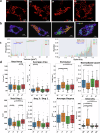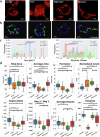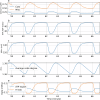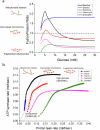Metabolic regulation of mitochondrial morphologies in pancreatic beta cells: coupling of bioenergetics and mitochondrial dynamics
- PMID: 39369076
- PMCID: PMC11455970
- DOI: 10.1038/s42003-024-06955-3
Metabolic regulation of mitochondrial morphologies in pancreatic beta cells: coupling of bioenergetics and mitochondrial dynamics
Abstract
Cellular bioenergetics and mitochondrial dynamics are crucial for the secretion of insulin by pancreatic beta cells in response to elevated levels of blood glucose. To elucidate the interactions between energy production and mitochondrial fission/fusion dynamics, we combine live-cell mitochondria imaging with biophysical-based modeling and graph-based network analysis. The aim is to determine the mechanism that regulates mitochondrial morphology and balances metabolic demands in pancreatic beta cells. A minimalistic differential equation-based model for beta cells is constructed that includes glycolysis, oxidative phosphorylation, calcium dynamics, and fission/fusion dynamics, with ATP synthase flux and proton leak flux as main regulators of mitochondrial dynamics. The model shows that mitochondrial fission occurs in response to hyperglycemia, starvation, ATP synthase inhibition, uncoupling, and diabetic conditions, in which the rate of proton leakage exceeds the rate of mitochondrial ATP synthesis. Under these metabolic challenges, the propensities of tip-to-tip fusion events simulated from the microscopy images of the mitochondrial networks are lower than those in the control group and prevent the formation of mitochondrial networks. The study provides a quantitative framework that couples bioenergetic regulation with mitochondrial dynamics, offering insights into how mitochondria adapt to metabolic challenges.
© 2024. The Author(s).
Conflict of interest statement
The authors declare no competing interests.
Figures










Similar articles
-
Direct Substrate Delivery Into Mitochondrial Fission-Deficient Pancreatic Islets Rescues Insulin Secretion.Diabetes. 2017 May;66(5):1247-1257. doi: 10.2337/db16-1088. Epub 2017 Feb 7. Diabetes. 2017. PMID: 28174288
-
Selective actions of mitochondrial fission/fusion genes on metabolism-secretion coupling in insulin-releasing cells.J Biol Chem. 2008 Nov 28;283(48):33347-56. doi: 10.1074/jbc.M806251200. Epub 2008 Oct 2. J Biol Chem. 2008. PMID: 18832378 Free PMC article.
-
Real-Time Imaging of Mitochondrial ATP Dynamics Reveals the Metabolic Setting of Single Cells.Cell Rep. 2018 Oct 9;25(2):501-512.e3. doi: 10.1016/j.celrep.2018.09.027. Cell Rep. 2018. PMID: 30304688 Free PMC article.
-
Mitochondrial dynamics in the regulation of nutrient utilization and energy expenditure.Cell Metab. 2013 Apr 2;17(4):491-506. doi: 10.1016/j.cmet.2013.03.002. Cell Metab. 2013. PMID: 23562075 Free PMC article. Review.
-
Emerging Concepts in Diabetes: Mitochondrial Dynamics and Glucose Homeostasis.Curr Diabetes Rev. 2017;13(4):370-385. doi: 10.2174/1573399812666151012115229. Curr Diabetes Rev. 2017. PMID: 26456359 Review.
References
MeSH terms
Substances
Grants and funding
LinkOut - more resources
Full Text Sources

